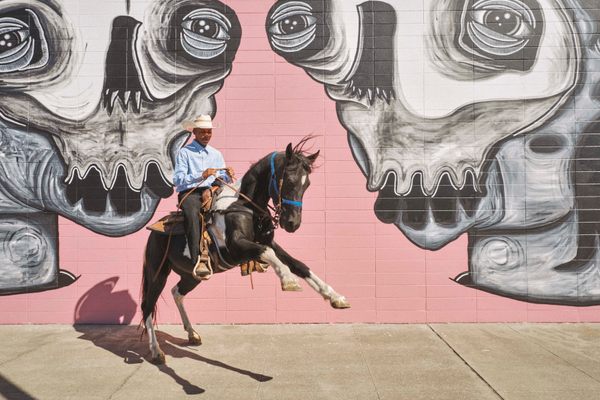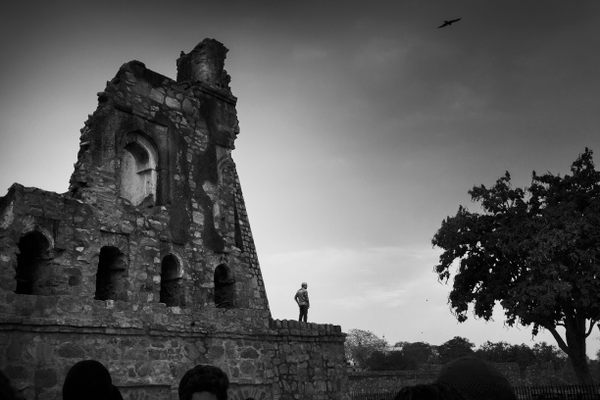Has the Afghan Box Camera Finally Met Its Match?
The unique portrait-maker has survived wars, invasions, and fundamentalist tyranny. But digital photography may be too much to overcome.
When I first started photographing, I couldn’t even reach the camera,” says Abdul Haq Baratali. His hands trace the contours of a wooden box that sits before him, brightly colored and decorated with patterned vinyl fabric. “I had to stand on a chair in order to operate it. My father had just died, there was no one to feed us, and I was unable to go to school. So I learned photography to earn for my family.”
The 69-year-old photographer is sitting on the porch outside his cluttered one-story house on the outskirts of Kabul, Afghanistan, remembering when he was six years old. Back then he had to use whatever was on hand—usually cameras from the Soviet Union, which he borrowed from his sister’s husband.
A few years later, however, things changed. A prominent carpenter in Kabul named Ali Ahmad gifted him a curious boxy camera—a kamra-e-faoree (“instant camera” in Dari). “Ali used to come to my sister’s husband’s shop, and he saw my interest in photography,” says Baratali. “He gave me a kamra-e-faoree of his to practice on.”
Used in Afghanistan for decades, the unique handmade device—like Baratali himself—has lived through a lot. Over the years, as its popularity waxed and waned, it survived the Soviet invasion in 1979, the civil war that followed it, Taliban rule in the 1990s, and successive conflicts in the years following the U.S.-led invasion in 2001.

But now the Afghan box camera is facing a foe it may not be able to overcome: digital photography. Its rise and ubiquity, along with other developments in Afghanistan—including legislative changes, dying knowledge of the art, and lack of access to the necessary materials—may do what wars, invasions, and fundamentalist tyranny have failed to accomplish: push the kamra-e-faoree to extinction in its homeland.
In the dappled afternoon light of a summer afternoon, Baratali is standing in the courtyard of his house in the Afghan capital, explaining the camera’s odd technology.
The kamra-e-faoree is a self-contained device—a manual camera and darkroom in one. The lenses are shutterless, so the camera utilizes an internal focusing system: A rod on the back of the box works with an adjustable sanded-glass plate inside. Chemicals and paper are stored within, in small trays.

The photographic process is completely analog, using only natural light to expose the paper. With the aid of an eyehole on top, the photographer can follow the development process in real time. To develop a negative by hand, the operator inserts an arm through a sleeve of cloth to access the camera’s interior.
In the past, says Baratali, “you would buy boxes of a hundred large photographic papers that you could cut into smaller pieces. The paper would come mainly from Japan, Germany, or Russia. We would make a fixer solution at home using Metol, sodium carbonate, and sodium sulphate … and a developer solution from Pakistan [that] used bromide.”
To balance out an image’s contrast, box-camera photographers would add a red tint to the negative. “If someone had something wrong with their eye in the photograph, we would put a little bit of sulphate on the pupil to fix it,” Baratali says with a wink.

Afghan box cameras were built by local carpenters, who made the structure sturdy enough to withstand Afghanistan’s extreme temperatures and survive Kabul’s narrow streets, no matter how precarious the transportation. The most prominent of these carpenters was Ali Abdul. Baratali remembers Abdul making most of the box cameras in Kabul, including the one he gave to Baratali. (To supplement his income, Abdul sold some cameras in nearby cities too.)
“He was fast,” says Baratali. “He could make one in a week. And no one else could make them like him.” Every box camera Abdul made was subtly different. Dealing with their idiosyncrasies—from light leakage to rickety tripod legs—was part of the photographer’s job.
In the 1950s, a kamra-e-faoree cost 500 Afghanis (roughly $6 in today’s U.S. dollars). For a time, portrait photographers in Kabul could eke out a living using the box camera. But not much more than that.
“On a good day,” Baratali says, “I would earn about 200 Afs ($2.50).” If he was very lucky, he’d get a customer who’d ask for large-print photos—or better still, hand-colored ones, which fetched a higher price.

As Baratali talks, he hunches over the albums that litter the floor of his home—shots from his military days showing jet planes at Shindand Airbase in Herat Province, gleeful young soldiers posing with rocket launchers and tanks, enlisted men sprawled out in poppy fields. “Army men would ask me to take their pictures, so that their families could see that they [were] healthy and alive in Kabul,” Baratali says.
His studio’s walls bear further witness to the past half century in Afghanistan—and to the singular camera that recorded it. Portraits of curious children and red-lipped men in flared trousers share space with shots of fellow street photographers at work.
“I would go and ask the ironsmith to create crowns for me to keep in the studio as props,” Baratali says. “Or we would give a client a wooden gun to hold in the photograph, to mimic the kings in the Bollywood movies.”
No one can pinpoint the exact origins of the kamra-e-faoree. Many photographers in Kabul say it reached Afghanistan from India in the 1950s, if not earlier. Before it arrived, the country had few photographers, and those that existed catered exclusively to the wealthy.

But the mid-1950s was a boom time for the kamra-e-faoree, especially in the country’s capital. Studios sprung up across Kabul. The camera’s low cost democratized portraiture for photographers and customers alike, allowing ordinary citizens to have their portraits taken relatively cheaply.
The camera served at least one other practical purpose. In the 1950s, legislation was passed requiring that the Afghan national identity card—the tazkira—have a photograph on it. The national government subsequently trained scores of new photographers to use the kamra-e-faoree and create instant IDs in towns and villages across the country. This provided a steady income for many of them—particularly for very young men, who found a niche market making portraits of women. (It was, and still is, more acceptable in Afghanistan for a boy to photograph a female customer than it is for an adult male to do so.)
Baratali would travel to the suburbs in search of work, taking his tripod and camera, which was encased in a brightly patterned box to attract passersby. “I would strap the camera on my bike and go from house to house to take people’s pictures,” he says. “Sometimes they would pay me in bread and eggs, because they were poor.”
Locals were transfixed by this peculiar device. In rural areas, the beautiful photographs it produced were the first images many customers had seen of themselves.

But when the Taliban came to power, in the 1990s, they banned photography, calling it an affront to Islam. Hanging a portrait or displaying an image—of any living creature—became a crime punishable by beating or imprisonment. Most Afghan box-camera operators hid or destroyed their equipment to avoid retribution.
Taliban leaders, however, decided to make an exception for themselves. Their hypocritical and narcissistic desire for photo IDs, ironically, allowed the trade to continue, as they permitted a few Afghan photographers to keep their box cameras.
In 2001, the invasion of Afghanistan by U.S. forces and their allies, and the subsequent fall of the Taliban, saw the Afghan photo industry flourish anew, as citizens rejoiced in their political and cultural liberation. Studios were quick to cash in on the fresh demand for personal and family portraits.
But by this time new camera models were available on the market—smaller and quicker, cheaper and more efficient. Another blow to the kamra-e-faoree came when Afghanistan’s educational system was overhauled, in 2001, and all compulsory ID photographs had to be in color, rendering the box camera’s services obsolete.

Baratali’s studio is still open today, but now it’s run by two of his sons. Baratali himself stopped working eight years ago. His eyesight is bad, his hands shake, and he can no longer carry the cumbersome camera. (The box on its own weighs about 18 pounds. The tripod is heavier still.)
But even if Baratali could work, he probably wouldn’t have much to do. In Afghanistan these days, the kamra-e-faoree is rarely seen in action. Over the years, as box cameras were outlawed or forgotten, many were thrown away or left to gather dust in their owners’ homes. Most are now unusable, with the materials they require to produce photos hard to come by in Kabul.
Digital photography, of course, has taken over the world. Photo studios today can now digitally reproduce old family portraits, remove tears and wrinkles, and create several copies of a single photograph that was taken decades ago with a box camera.

“People don’t use this camera anymore,” says Baratali, “because they can take pictures on digital cameras and mobile phones. These cameras will die out eventually. But I’m grateful, because this camera allowed me to earn a living. If I didn’t learn photography, I probably would [have been] a laborer, burning under the sun every day, or pushing dirt around.”
As he approaches his 70th birthday, Baratali shares his deep knowledge and photographic craftsmanship with his four children and 33 grandchildren. Most photo studios in Afghanistan are family operations, and the pride of passing down a craft runs deep in Afghan culture. Baratali knows that the box camera’s time in Kabul has come and gone, but nevertheless hopes—like most artisans do—that his descendants will continue to practice his craft long after he’s gone. The truth, however, is that there simply isn’t much work today for the humble box camera in Afghanistan.
Elsewhere, however, is a different matter. While the kamra-e-faoree may be nearly extinct in Afghanistan, it has captured the imagination of a new audience abroad. In the wealthy Western world, it seems to be enjoying a renaissance.

Fascinated by its simplicity and colorful history, vintage-photography fanatics in the U.S. and Europe are able and eager to purchase the materials necessary to operate it—materials that low-income photographers in Kabul can no longer afford or access. Many are now learning how to build and use Afghan box cameras as a hobby.
What began as an artistic but pragmatic means of survival for Baratali and his cohort in Afghanistan may now, ironically, live on as an elite niche item far beyond the historic streets of Kabul. Baratali understands this, and philosophically accepts the fact that change is something both constant and eternal. But for him, hope remains.
“In life, people progress,” he says. “They don’t go backward. They will build new cameras, and [box] cameras will be gone eventually. But my hope is that our story of Afghanistan won’t be forgotten. I hope it lives on through kamra-e-faoree photographs.”




















Follow us on Twitter to get the latest on the world's hidden wonders.
Like us on Facebook to get the latest on the world's hidden wonders.
Follow us on Twitter Like us on Facebook